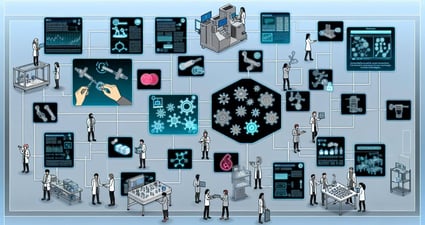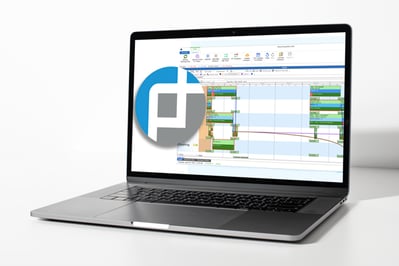Collaborative Manufacturing Ecosystems
Precision, efficiency, and compliance are vital in medical manufacturing, the role of Operations Directors has never been more critical. As stewards of production excellence, they are constantly seeking ways to optimize processes, enhance collaboration, and elevate outcomes. Amidst this pursuit, a transformative paradigm has emerged: Collaborative Manufacturing Ecosystems.
This blog looks into the essence of this paradigm shift, exploring its significance, benefits, and the pivotal role of integration between PlanetTogether and leading ERP, SCM, and MES systems.

Collaborative Manufacturing Ecosystems
Traditional manufacturing setups often operate in silos, where departments function independently, leading to fragmented workflows, communication gaps, and inefficiencies. Collaborative Manufacturing Ecosystems represent a departure from this siloed approach, fostering synergy across the entire manufacturing landscape. At its core, it embodies seamless collaboration among people, processes, and technologies, transcending organizational boundaries to drive holistic optimization.

Key Components of Collaborative Manufacturing Ecosystems
Integration: Central to the success of Collaborative Manufacturing Ecosystems is integration. By connecting disparate systems such as Enterprise Resource Planning (ERP), Supply Chain Management (SCM), Manufacturing Execution Systems (MES), and advanced planning tools like PlanetTogether, organizations can achieve a unified data environment. This integration ensures real-time visibility, streamlined workflows, and data-driven decision-making.
Interoperability: Beyond mere integration, interoperability enables systems to communicate effectively and exchange data seamlessly. Whether it's syncing production schedules between PlanetTogether and ERP systems like SAP, Oracle, Microsoft Dynamics, or linking MES solutions for real-time monitoring and control, interoperability paves the way for synchronized operations.
Collaborative Tools: Leveraging collaborative tools and platforms fosters cross-functional teamwork and knowledge sharing. From cloud-based collaboration suites to project management platforms, these tools empower teams to collaborate irrespective of geographical barriers, accelerating problem-solving and innovation.
Data Analytics: Harnessing the power of data analytics within Collaborative Manufacturing Ecosystems enables predictive insights and continuous improvement. By leveraging historical data, machine learning algorithms, and predictive analytics, organizations can anticipate demand fluctuations, optimize resource allocation, and preempt potential bottlenecks.

Benefits of Collaborative Manufacturing Ecosystems
Enhanced Agility: By breaking down silos and fostering collaboration, organizations can adapt swiftly to market dynamics, regulatory changes, and unforeseen disruptions. Agile responses to demand fluctuations, supply chain disruptions, and regulatory mandates become feasible, ensuring sustained competitiveness.
Optimized Resource Utilization: Collaborative Manufacturing Ecosystems enable optimized resource allocation through real-time visibility and predictive analytics. Whether it's workforce scheduling, equipment utilization, or raw material management, organizations can maximize efficiency while minimizing waste.
Improved Quality and Compliance: With integrated quality management systems and real-time monitoring capabilities, organizations can uphold stringent quality standards and regulatory compliance. Enhanced traceability, documentation, and audit trails ensure product integrity and regulatory adherence.
Accelerated Innovation: By fostering cross-functional collaboration and knowledge sharing, Collaborative Manufacturing Ecosystems spur innovation. Whether it's process improvements, product enhancements, or technology adoption, organizations can drive continuous innovation to stay ahead in the competitive landscape.

Integration between PlanetTogether and Leading ERP, SCM, and MES Systems
Integration between PlanetTogether and prominent ERP, SCM, and MES systems such as SAP, Oracle, Microsoft Dynamics, Kinaxis, and Aveva holds immense significance within Collaborative Manufacturing Ecosystems. This integration facilitates:
Unified Planning: Seamlessly synchronize production planning and scheduling data between PlanetTogether and ERP systems, ensuring alignment with demand forecasts, inventory levels, and resource capacities.
Real-Time Visibility: Enable real-time visibility into production progress, inventory levels, and resource utilization by integrating MES solutions with PlanetTogether, facilitating proactive decision-making and agile responses to changing conditions.
Efficient Order Fulfillment: Streamline order fulfillment processes by integrating SCM systems with PlanetTogether, enabling seamless coordination of procurement, production, and distribution activities to meet customer demands effectively.
Quality Management: Facilitate integration between quality management systems and PlanetTogether to ensure adherence to quality standards, regulatory requirements, and continuous improvement initiatives throughout the manufacturing lifecycle.
Collaborative Manufacturing Ecosystems herald a new era of excellence in medical manufacturing, empowering Operations Directors to orchestrate synchronized operations, drive innovation, and deliver superior outcomes.
By embracing integration between PlanetTogether and leading ERP, SCM, and MES systems, organizations can realize the full potential of this paradigm shift, unlocking agility, efficiency, and innovation across the manufacturing landscape.
As stewards of this transformation, Operations Directors play a pivotal role in charting the course towards manufacturing excellence in the ever-evolving healthcare landscape. Are you ready to take your manufacturing operations to the next level? Contact us today to learn more about how PlanetTogether can help you achieve your goals and drive success in your industry.